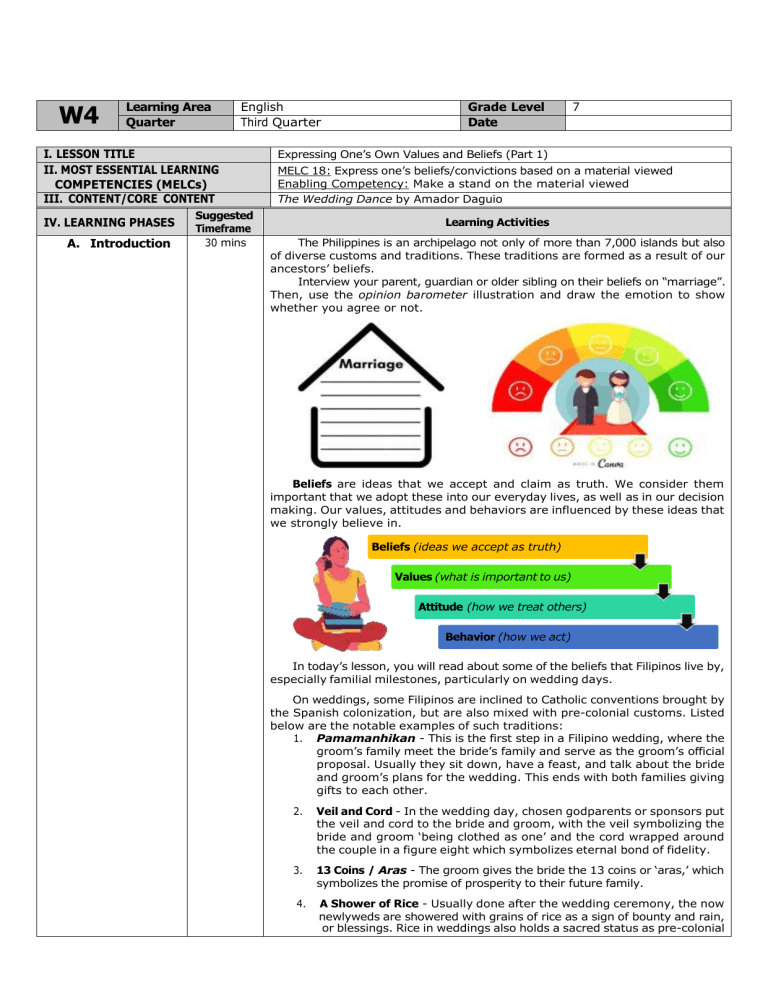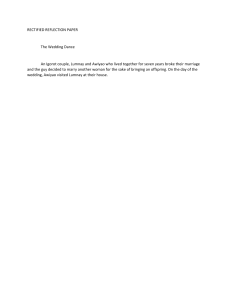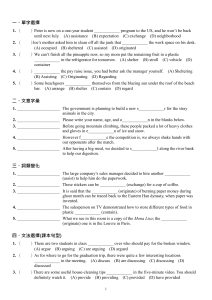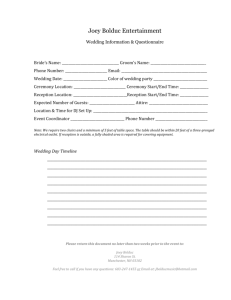
W4 Learning Area Quarter English Third Quarter I. LESSON TITLE II. MOST ESSENTIAL LEARNING COMPETENCIES (MELCs) III. CONTENT/CORE CONTENT IV. LEARNING PHASES A. Introduction Suggested Timeframe 30 mins Grade Level Date 7 Expressing One’s Own Values and Beliefs (Part 1) MELC 18: Express one’s beliefs/convictions based on a material viewed Enabling Competency: Make a stand on the material viewed The Wedding Dance by Amador Daguio Learning Activities The Philippines is an archipelago not only of more than 7,000 islands but also of diverse customs and traditions. These traditions are formed as a result of our ancestors’ beliefs. Interview your parent, guardian or older sibling on their beliefs on “marriage”. Then, use the opinion barometer illustration and draw the emotion to show whether you agree or not. Beliefs are ideas that we accept and claim as truth. We consider them important that we adopt these into our everyday lives, as well as in our decision making. Our values, attitudes and behaviors are influenced by these ideas that we strongly believe in. Beliefs (ideas we accept as truth) Values (what is important to us) Attitude (how we treat others) Behavior (how we act) In today’s lesson, you will read about some of the beliefs that Filipinos live by, especially familial milestones, particularly on wedding days. On weddings, some Filipinos are inclined to Catholic conventions brought by the Spanish colonization, but are also mixed with pre-colonial customs. Listed below are the notable examples of such traditions: 1. Pamamanhikan - This is the first step in a Filipino wedding, where the groom’s family meet the bride’s family and serve as the groom’s official proposal. Usually they sit down, have a feast, and talk about the bride and groom’s plans for the wedding. This ends with both families giving gifts to each other. 2. Veil and Cord - In the wedding day, chosen godparents or sponsors put the veil and cord to the bride and groom, with the veil symbolizing the bride and groom ‘being clothed as one’ and the cord wrapped around the couple in a figure eight which symbolizes eternal bond of fidelity. 3. 13 Coins / Aras - The groom gives the bride the 13 coins or ‘aras,’ which symbolizes the promise of prosperity to their future family. 4. A Shower of Rice - Usually done after the wedding ceremony, the now newlyweds are showered with grains of rice as a sign of bounty and rain, or blessings. Rice in weddings also holds a sacred status as pre-colonial IV. LEARNING PHASES Suggested Timeframe Learning Activities Filipinos are bound with hands held together over a mound of rice blessed by a Babaylan or priestess, which then becomes their first shared meal. 5. Money Dance / Gala - this dance is usually the first dance of the newlyweds, whereas sponsors, family relatives, and guests pin bills to the bride and groom’s clothes, which is considered a way to help the couple get started in their married life financially. Individuals have different points of view on subjects and how they express themselves in comparison to others. Consider the questions listed below while reading the story that follows. How does a person stand up for a belief? What skills are required to take such a stand? What are the challenges and risks involved when someone takes such a stand? B. Development 1 hour and 30 mins Read the excerpt of the short story titled, “The Wedding Dance” by Amador Daguio, a Filipino writer from Lubuagan, Kalinga before the World War II. The Wedding Dance Amador Daguio The story is set in the mountains of northern Philippines, in a traditional community unspoiled by outside influence. The story may have happened before or after the Second World War, one summer night before harvest time. Awiyao is a strong, muscular, industrious member of the tribe. He’d been married to Lumnay for seven years yet without children. He loves Lumnay and was a good husband to her, but he is forced to take another wife as the laws of their society dictate. Lumnay is a tough, graceful woman who is also an industrious worker. She was a loving wife to Awiyao, but after the failure to give him an offspring, she has to suffer separation from the love of her life. Madulimay is the woman chosen to be Awiyao’s new wife. She holds the promise of the continuity of Awiyao’s lineage. So here, we have a forced love triangle. On the night of the festivities for his second wedding, Awiyao visits his first wife Lumnay in the house he built for her. Awiyao is worried that Lumnay is not among the wedding dancers. He invites her to the dance, but she remains still. He apologizes to her and explains why the situation between them had to be this way. It is clear that they understood each other. They do not point fingers nor judge one another. Awiyao expresses his admiration and love for his wife and his regret for giving in to the pressure of producing an offspring. He encourages Lumnay to accept another husband. Lumnay, however, is adamant and stands her ground — she will love only one man. Awiyao promises to come back to her if he fails again for the second time, but Lumnay wishes him and his new wife only blessings from Kabunyan. She admits to him how difficult the situation is for her. When Awiyao is called back to the dance, he pauses as if to think over his decision. Lumnay accepts his invitation to the dance and plucks up her courage to face her tribe, the joys of the past and the pains memories keep bringing her. But then, Lumnay stops to reflect on her fate questioning why they had to separate and plans to air her dissension to the tribe. However, she changes her mind and runs away from the ceremony toward the bean fields where she lingers for a long while to be with the beans, the produce she is able to breed. Learning Task 1: After reading the excerpt, answer the following questions. Write your answers on your paper. IV. LEARNING PHASES Suggested Timeframe Learning Activities 1. 2. 3. 4. 5. What is the situation of Awiyao and Lumnay’s marriage? How did Lumnay respond to Awiyao when he invited him to come to the wedding dance? What was expected of them during their time of marriage? Were they able to fulfill it? Do you think Awiyao and Lumnay love each other? Explain your answer. If you were in the situation of Awiyao and Lumnay, would you defy your tribe’s tradition? Why or why not? Learning Task 2: Let us know us know more about the characters of the story. Copy and fill out the character graphic organizer below with the needed information. Write your answers on your paper. Awiyao Lumnay 1. Describe the character’s traits. 2. What does the character want and why? 3. How did they respond to their situation in the story? 4. Do you agree with their beliefs and actions? Why or why not? Learning Task 3: On your paper, write a ten-sentence paragraph reflection about one of the themes of the story you have read like the one mentioned in the illustration. You may indicate in your paragraph whether you agree with the theme or not. “Love doesn’t always conquer everything.” Your paragraph will be graded based on the following criteria, Organization (5 pts), Content (5pts), Writing Mechanics (5pts). C. Engagement 1 hour and 15 mins Learning Task 4: For your final task, using an old cardboard and other available materials at home, create a bookmark that contains a quote that you strongly believe in. Then, on your paper, write at least three sentences explaining why you believe in it. You may refer to the rubric below to serve as your guide in accomplishing this activity. Criteria Creativity (design, color and layout) Originality (uniqueness) Presentation (neat and presentable) Mechanics (spelling and grammar) Score 10 8 6 4 / 40 2 IV. LEARNING PHASES D. Assimilation V. ASSESSMENT Suggested Timeframe 15 mins 15 mins Learning Activities In this lesson, it can be derived that Filipinos, particularly ethnic groups, have exclusive customs and traditions that they hold important to their tribe. Each has colorful stories to tell that represent Filipino beliefs/convictions. These stories, legends, folklore, and novels from different parts of the country shape our moral being and connect us deeper into our roots. Our nation's rich history as a country that endures many wars and invaders pave the way for people of distinct cultures and beliefs. These may be retained throughout the course of time, but with the continuing modernization of our country, such customs may change. But one thing that we will always have in common is being a Filipino. Instructions: List down the customs and beliefs mentioned or implied in the story you have read. Next, put a check (✔) whether you agree or disagree with them. Then, write down your explanations regarding your response. Customs/Beliefs VI. REFLECTION 15 mins Agree Disagree Explanation Instructions: On your paper, write your insights about the lesson using the prompts below. I understand that . I realize that . I need to learn more about . Prepared by: Checked by: Jia Marie T. Alvarado, T-III James M. Yama, HT-I



